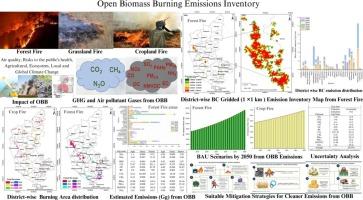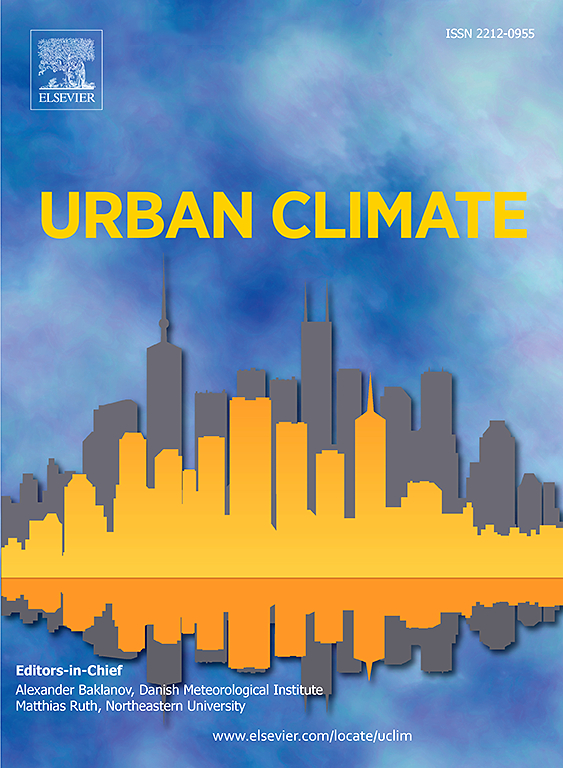为印度卡纳塔克邦露天生物质燃烧的空气质量评估和减排战略编制 1 × 1 km 网格排放清单
IF 6
2区 工程技术
Q1 ENVIRONMENTAL SCIENCES
引用次数: 0
摘要
在这项工作中,我们编制了卡纳塔克邦 2000 年、2005 年、2010 年、2015 年、2020 年和 2022 年露天生物质燃烧(OBB)产生的温室气体和空气污染物的高分辨率(1 × 1 千米网格)排放清单。二手数据集和实地数据集被用来验证排放清单。基于地理信息系统的统计模型和活动数据被用来估算露天燃烧(森林、草原和农作物火灾)产生的温室气体和空气污染气体排放量。使用蒙特卡罗模拟(MCS)模型对排放量进行了不确定性分析,并使用低排放分析平台(LEAP)工具根据年平均增长率预测了到 2050 年的排放量。根据我们的结果,卡纳塔克邦在上述年份中烧毁的 OBB 总面积(%)分别为 24.43、15.69、15.95、11.41、26.73 和 5.78。结果表明,2000-2022 年卡纳塔克邦以千兆克为单位的年均 OBB 排放总量分别为二氧化硫 (6.67)、氮氧化物 (9.48)、氢氧化氮 (9.80)、一氧化碳 (670.12)、有机碳 (59.78)、碳酸氢盐 (5.09)、二氧化碳 (11071.11)、甲烷 (33.68)、可吸入颗粒物 (84.29)、细颗粒物 (81.08)、非甲烷总挥发性有机化合物 (74.13) 和二氧化氮 (4.80)。从 2000 年到 2022 年,卡纳塔克邦的卡尔伯吉、雷丘尔、巴加尔科特、乌塔拉卡纳达和希瓦莫加地区的 OBB 排放量最高。排放不确定性结果显示,作物、草原和森林火灾的排放不确定性分别为±26.92%、±28.17%和±30.27%。在 "一切照旧"(BAU)情景下,预计到 2030 年,森林、草原和农作物火灾产生的甲烷排放量分别为 8823、2.64 和 5262 公吨,到 2050 年分别为 58046、10 和 30700 公吨。开发的高分辨率清单是最新的地表排放数据集,其中包含卡纳塔克邦的奥BB 排放热点。根据国家清洁空气计划(NCAP)和印度到 2070 年实现净零排放的目标,我们的高分辨率排放清单和减排策略可能有助于印度卡纳塔克邦的空气质量监测、健康效益分析和政策制定研究。本文章由计算机程序翻译,如有差异,请以英文原文为准。

Development of 1 ×1 km gridded emission inventory for air quality assessment and mitigation strategies from open biomass burning in Karnataka, India
In this work, we have developed a high-resolution (1 ×1 km grid) emission inventory of greenhouse gases and air pollutants from open biomass burning (OBB) in Karnataka for 2000, 2005, 2010, 2015, 2020, and 2022. Secondary and field datasets were used to validate the emission inventories. The GIS-based statistical model and activity data were used to estimate greenhouse and air pollutant gas emissions from OBB (Forest, grassland, and crop fires). The uncertainty analysis of the emissions were done using the Monte Carlo Simulation (MCS) model and Low Emission Analysis Platform (LEAP) tool was used for projecting the emissions to 2050 based on the annual average growth rate. According to our results, the total OBB burned areas (%) in Karnataka during the aforementioned years were 24.43, 15.69, 15.95, 11.41, 26.73, and 5.78. The results showed that total annual average OBB emissions in Karnataka for 2000–2022 in Gg were SO2 (6.67), NOx (9.48), NH3(9.80), CO (670.12), OC (59.78), BC (5.09), CO2 (11071 .11), CH4(33.68), PM10(84.29), PM2.5(81.08), NMVOC (74.13), and NO2 (4.80) respectively. The districts of Kalburgi, Raichur, Bagalkot, Uttara Kannada, and Shivamogga have the highest emissions from OBB in Karnataka from 2000 to 2022. The emission uncertainty results showed ±26.92, ±28.17, and ±30.27 % for the crop, grassland, and forest fires, respectively. Under the business-as-usual (BAU) scenarios, the CH4 emissions from forest, grassland, and crop fires are projected at 8823, 2.64, and 5262 metric tonnes by 2030 and 58046, 10, and 30700 metric tonnes by 2050, respectively. The developed high-resolution inventories are the most up-to-date surface emission datasets with hotspots in Karnataka from OBB emission. National Clean Air Programme (NCAP) and India’s Net-Zero Emission target by 2070, our high-resolution emission inventories and mitigation strategies may be helpful for air quality monitoring, health benefits analysis, and policy-making studies in Karnataka, India.
求助全文
通过发布文献求助,成功后即可免费获取论文全文。
去求助
来源期刊

Urban Climate
Social Sciences-Urban Studies
CiteScore
9.70
自引率
9.40%
发文量
286
期刊介绍:
Urban Climate serves the scientific and decision making communities with the publication of research on theory, science and applications relevant to understanding urban climatic conditions and change in relation to their geography and to demographic, socioeconomic, institutional, technological and environmental dynamics and global change. Targeted towards both disciplinary and interdisciplinary audiences, this journal publishes original research papers, comprehensive review articles, book reviews, and short communications on topics including, but not limited to, the following:
Urban meteorology and climate[...]
Urban environmental pollution[...]
Adaptation to global change[...]
Urban economic and social issues[...]
Research Approaches[...]
 求助内容:
求助内容: 应助结果提醒方式:
应助结果提醒方式:


